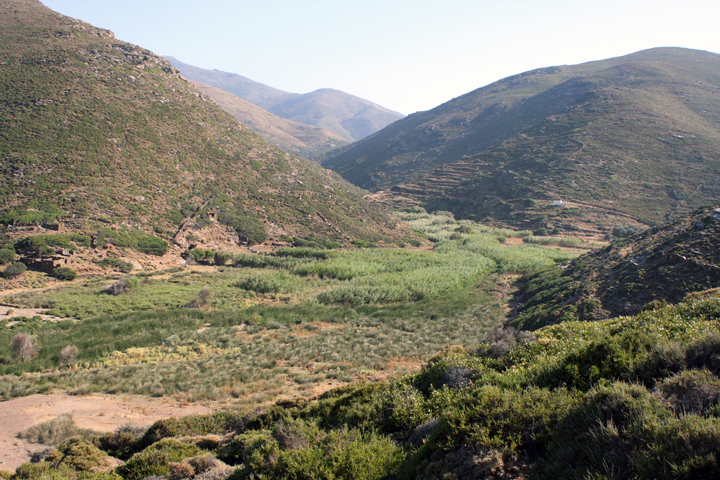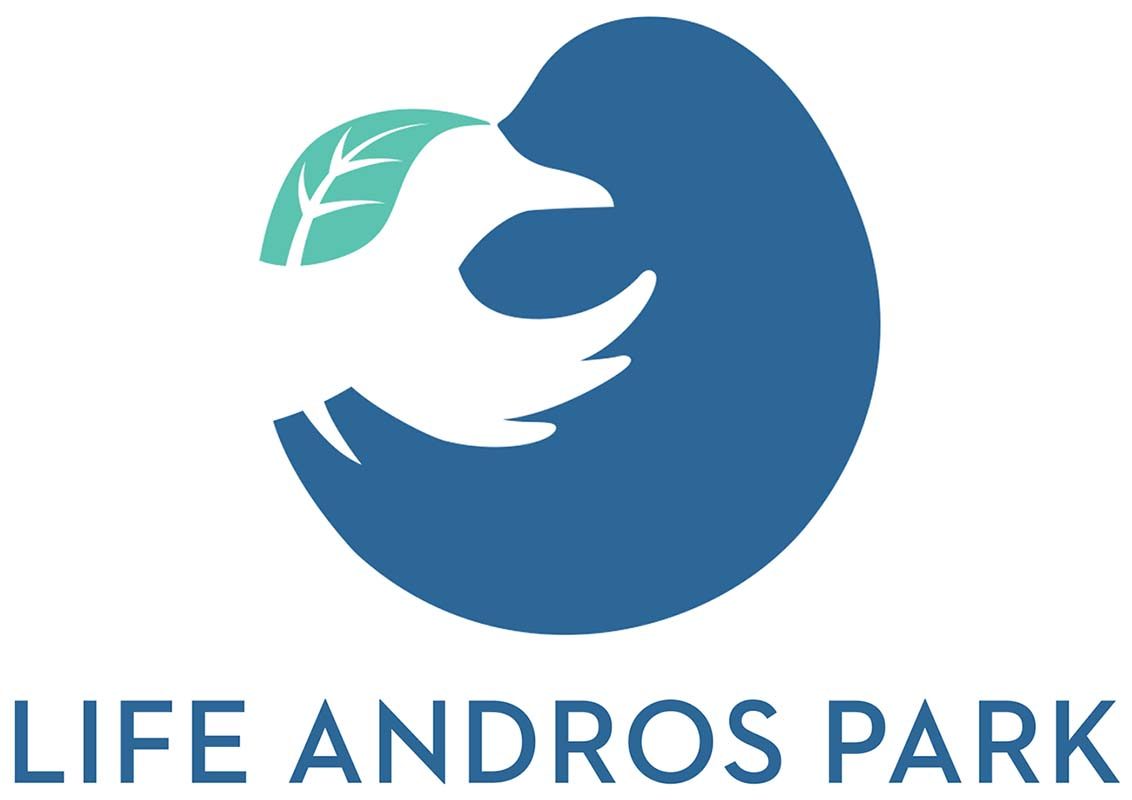The terrestrial geological substrate of the project area mainly consists of schists of various types, while limestone is found only in small areas. The non-limestone substrate is the main reason for the comparatively moist conditions in large parts of the area. Increased local precipitation and moisture are also caused by the NW-SE position and the relatively high mountains of the island.
Frequent cloud formation over Mt. Kouvaras (990 m) is the result of prevailing north winds (mainly during summer) in association with relatively high air humidity. Only lowlands situated far from the mountains exhibit a very dry summer and early autumn period, typical of the Cyclades climate. The mountain valleys and the north-facing mountain sides are moist and green throughout the summer with several small rivers and rivulets of constant water flow. This is evidenced by the presence of water turtles, fresh-water crabs, water-snakes (Natrix natrix), eels and small fishes as well as a large number of invertebrates. As a result, there is a great diversity of habitat and biotopes, most important being the alluvial alder forest (habitat code: 91E0*).

The project’s greater terrestrial area is also covered by phrygana and rocky parts, while there are also ravines, temporary streams, ponds and wetlands. A large part of the site is covered by Sarcopoterium spinosum phrygana (habitat code: 5420), which is characterized by the presence of several xerophytic shrubs like Genista acanthoclada, Satureja thymbra, Erica manipuliflora, Cistus salviifolius. Siliceous rocky slopes with chasmophytic vegetation (habitat code: 8220) is the typical habitat type in the abundant rocky outcrops of the site. This habitat type is rich in endemic floristic elements such as Campanula sartorii, Erysimum senoneri ssp. senoneri, etc. Forest vegetation is mainly restricted to valleys and mountain slopes of the site, with small Quercus ilex and Q. pubescens stands in humid places, while Q. coccifera stands (habitat code: 934A) and Quercus macrolepis formations exist in the dry areas of the site. Along the main streams of the area Platanus orientalis woods (Platanion orientalis) (habitat code: 92C0) and southern riparian galleries and thickets (Nerio-Tamaricetea) (habitat code: 92D0) occur. Alluvial deposits are covered by the target habitat type, i.e. alluvial forests with A. glutinosa (Alno-Padion, Alnion incanae, Salicion albae) (91E0*), reedbeds, water courses of plain to montane levels with Callitricho-Batrachion vegetation (habitat code: 3260) and Mediterranean tall humid grasslands of the Molinio-Holoschoenion (habitat code: 6420) vegetation. In small alluvial deposits along the main streams of the site, A. glutinosa stands also occur often mixed with P. orientalis, Fraxinus ornus, Laurus nobilis, Myrtus communis, etc. The area hosts Bonelli’s Eagles (Aquila fasciata) (2-3 breeding pairs) and Peregrine Falcons (Falco peregrinus) (2 breeding pairs) which are resident species found in steep gorges and cliffs.
The coastline of the area is mainly rocky consisting of highly weathered metamorphic rocks (schists), forming eroding cliffs intermittent with numerous sandy beaches with shallow waters. Several perennial streams flow in the area forming small coastal wetlands. Islets are generally low-lying or flat with a smooth relief. The rocky coasts of the site are occupied by halophytic communities (habitat code: 1240) and phrygana, while embryonic shifting dunes (habitat code: 2110) and Malcolmietalia dune grasslands (habitat code: 2230) occur at the sandy beaches. The rocky coasts and 16 adjacent uninhabited islets are very important nesting and roosting areas for the Mediterranean Shag, the Audouin’s Gull and the Eleonora’s Falco. The extensive rocky parts of the coastline of the island of Andros which include numerous partially or totally submerged marine caves (priority habitat 8330*) which are of significant importance for the Mediterranean monk seal, particularly for pupping and resting.
It is also noteworthy that human activities in the area do not have such an adverse impact as it happens in other Greek islands with more intense touristic development. Main threats include construction of roads and expansion of human settlements, garbage disposal, wetland degradation, overgrazing, heavy flooding of rivers and streams (intensified in size and frequency as a result of recent wild fires) abandonment of traditional farming practices and (more recently) possible construction of wind farms and associated power lines. In addition, soil erosion strongly affects the hydrological cycle of the site and the directly dependent habitat types.
